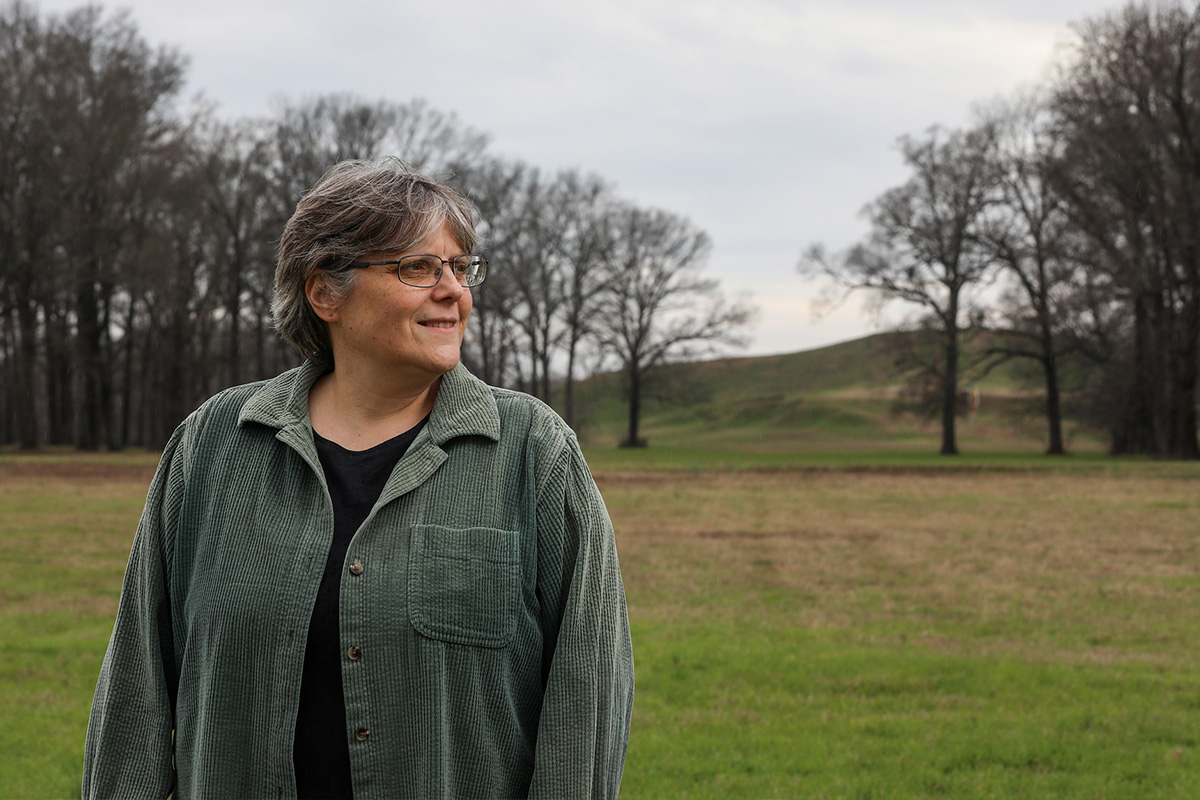

CAPTION: Dr. Diana Greenlee serves as the ULM Station Archaeologist at the Poverty Point World Heritage Site in Northeast Louisiana. She is part of the 2024 class of The Explorers Club 50, recognizing those dedicated to promoting science and exploration. Photo credit: Emerald McIntyre
MONROE, LA– ULM Station Archaeologist, Dr. Diana Greenlee, has been named to the Explorers Club 50 Class of 2024 for her achievements at the Poverty Point World Heritage Site.
The Explorers Club 50 chose to honor Dr. Greenlee because of her dedication to preserving the 3,400-year-old earthworks site and encouraging public knowledge surrounding Poverty Point’s historical significance. Dr. Greenlee was nominated by Dr. Richard Wiese, the President Emeritus and Explorers Club 50 Chair.
The Explorers Club selects 50 people each year to recognize their work in promoting science and exploration, specifically those unknown to most people. The Explorers Club’s mission is to “redefine exploration and enrich our knowledge of the world around us.” Over 51 countries represent the applications and 1,600 applicants since the Explorers Club’s founding in 2020.
“To be one of 200 researchers worldwide, who were selected for this honor, is unreal,” Dr. Greenlee said.
Dr. Greenlee hopes to connect with other EC50 and Explorers Club members to establish collaboration regarding the expansion of research and outreach beyond her current efforts.
Along with collaboration, Dr. Greenlee hopes to gain attention to Poverty Point WHS and raise awareness about the importance of preserving archaeological sites.
“There is so much yet to learn about our past and I am certain that future technologies will allow us to investigate the archaeological record in new ways,” Dr. Greenlee said.
During her time as a college student, Dr. Greenlee chose archaeology to satisfy her interests in science, history and art. She said she enjoyed the challenge of applying scientific methods to history and finding creative ways to share historical information.
Since 2006, Dr. Greenlee has explored Poverty Point WHS through a variety of measures, including remote sensing technology, surface survey, soil coring and target excavation.
Dr. Greenlee states that her research goes beyond exploring for discovery. She utilizes their findings to develop knowledge regarding archaeological deposits to protect them.
“Beyond documenting the above-ground earthworks, I collaborate to apply minimally invasive, remote-sensing technologies to ‘see’ underground features,” Dr. Greenlee said. “Knowing both above and below ground conditions allows us to avoid accidental harm to subtle landscape features and identify and mitigate threats like erosion.”
Along with these protective methods, Dr. Greenlee studies plant and animal resources utilization as well as the technology and raw materials that indigenous people fashioned for tools and ornaments.
“Poverty Point WHS is a remarkably complex archaeological site and while we know a lot about it and the indigenous people who created it, there is so much more we can learn,” Dr. Greenlee said. “I am not afraid to say, ‘I don’t know’ to questions and I enjoy the challenge of figuring out ways to answer those questions.”
Dr. Greenlee provides outreach activities to encourage public knowledge surrounding Poverty Point WHS, including exhibits, talks and hands-on participation opportunities in select projects. Dr. Greenlee said she strives for the public to know they continuously learn about the indigenous culture at Poverty Point WHS.
“By bringing people along on my archaeological journey, I emphasize how new methods and technologies provide diverse information, enhancing our understanding of the past,” Dr. Greenlee said.
In 2014, Dr. Greenlee collaborated with several experts to advance the knowledge of Poverty Point WHS through the inclusion on the UNESCO World Heritage List. According to Dr. Greenlee, the inscription of Poverty Point WHS on the UNESCO World Heritage List is the most significant achievement in her career.
“This intricate process took almost eight years, involving stakeholder meetings and building support, particularly from indigenous tribes, state and local officials and the local community,” Dr. Greenlee said. “Today, an annual ‘Poverty Point World Heritage Festival’ celebrates the site, reflecting the success of the effort initiated when few people initially understood it.”
Dr. Greenlee’s role as Poverty Point Station Archaeologist is a full-time pursuit. Through her work at Poverty Point, Greenlee’s work includes fielding questions from ULM students and members of the public who contact her through the ULM School of Sciences. She has also occasionally offered archaeological field schools during summer and winter sessions which provide an opportunity for ULM students to experience archaeological fieldwork. In 2022, Greenlee completed a new archaeology exhibit in the ULM Museum of Natural History, which is housed in Hanna Hall on ULM’s main campus.
For more information regarding the Explorers Club 50 and Poverty Point WHS, visit the links.